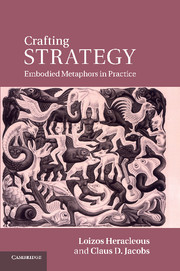Book contents
- Frontmatter
- Contents
- List of figures
- List of tables
- Preface
- Acknowledgments
- Vignette A BASF PerForm
- Vignette B UNICEF
- 2 Metaphor and embodied realism
- 3 Analyzing embodied metaphors as an interpretive, hermeneutic endeavor
- Vignette C Project Voltigo
- Vignette D Hephata Foundation
- Vignette E Privatbank IHAG Zürich AG
- Vignette F World Vision New Zealand
- Glossary
- Index
- References
3 - Analyzing embodied metaphors as an interpretive, hermeneutic endeavor
Published online by Cambridge University Press: 05 June 2011
- Frontmatter
- Contents
- List of figures
- List of tables
- Preface
- Acknowledgments
- Vignette A BASF PerForm
- Vignette B UNICEF
- 2 Metaphor and embodied realism
- 3 Analyzing embodied metaphors as an interpretive, hermeneutic endeavor
- Vignette C Project Voltigo
- Vignette D Hephata Foundation
- Vignette E Privatbank IHAG Zürich AG
- Vignette F World Vision New Zealand
- Glossary
- Index
- References
Summary
In this chapter we continue discussing the theoretical antecedents of our approach, by outlining some key conceptual orientations and analytical directions suggested by interpretive theory as well as hermeneutics as a key interpretive approach, that have informed how we conceptualize and analyze embodied metaphors. We begin with the concern with verstehen, the effort to understand how agents see their own situation both in and through their symbolic artifacts, and in turn employ this understanding in our interpretations of the symbolic artifacts agents produce, be it texts or embodied metaphors analysed as texts, to reach explanations adequate at the level of meaning. We also address the inseparability of action and structure, where actions can inform an understanding of context, and vice versa; the constitutive role of language not just as representation but as shaper of thought; and the multiplicity of meanings where iterations between part and whole can enrich interpretation further until an acceptable saturation of meaning can be reached. Finally, we note the contextuality and historicity of meaning, not just as embedded in the text analyzed but also as encoded in the researcher's pre-understandings that inform the interpretation. We address all of these considerations and how they relate to the interpretation of embodied metaphors.
- Type
- Chapter
- Information
- Crafting StrategyEmbodied Metaphors in Practice, pp. 42 - 60Publisher: Cambridge University PressPrint publication year: 2011



